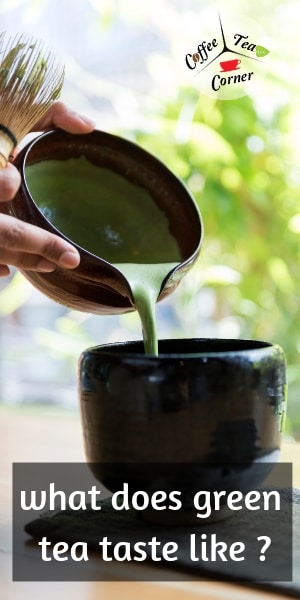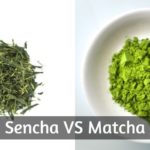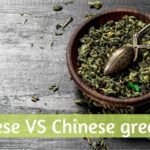If you've never had green tea, you might be wondering what it tastes like. There's so many people talking about the health benefits, but few bother to actually explain what green tea tastes like, for those who would like a clear idea before venturing this way.
So, here's what green tea tastes like, and I'm also going to talk about how the way it was processed influences the final taste. And how the flavorings work towards that.

Table of Contents
So what does green tea taste like ?
Green tea has a distinct 'green', grassy taste to it. It may remind you of green grapes, zucchini, seaweed and have a bit of an earthy taste as well.
There's tannin in green tea, which gives it a slight bitterness, and you'll definitely feel it on the sides of your tongue, towards the back.
Steamed green tea has a more delicate flavor, retaining much of the floral notes while toasted green tea has a earthy flavor.
To folks who are not accustomed to green tea, at first it might taste like grass. Of course, the taste depends on the quality of the green tea you're drinking.
We're used to teas that have a sweet tinge, and a fruity or floral aroma. Green tea is neither, on its own. It's a distinctly "green" taste, reminding some of freshly cut grass and green grapes.
Green tea, more than black tea, is an acquired taste, one you're more likely to have to learn to like rather than just fall in love with on the spot.
There are ways to make green tea more palatable, and we'll get into those too. But first let's explore why green tea has that grassy, green taste in the first place.
Why green tea leans towards the grassy side to begin with
Green tea goes back into history, both as a ceremonial drink, a healing drink, and a drink to have around the home. It was part of Eastern culture for longer than the West has known it.
The green, grassy taste remained in place partly because of the health benefits it brings, and by the power of habit. It was passed down each generation as the way green tea should taste, and it's the way it remained since the beginning.
Of course, there isn't much one can do the tea plant itself in terms of making it more like a fruity tea. There are green tea plants that can develop a honey-like taste, or a citrusy flavor, but it will still be an overwhelmingly green tea.
The taste of the green tea itself is given by the age of the tea leaf used, and also the way the leaf was processed. What I mean is that for green tea, younger leaves of the Camellia sinensis plant are used.
The eldest leaves are used for black tea, while the youngest sprouts and spears are used for white tea. This leaves young adult green leaves as the ones used for green tea.
The leaves are bright green, fresh, and they have a distinctly bitter flavor when raw.
Such a trait was cherished in the green tea, and it was preserved as much as possible. Some green teas can actually give a greenish infusion, if brewed right.
When you first have green tea and notice its green taste, know that a large part of it is given by the tannins found in the leaves themselves. This is an antioxidant, and it's also found in grapes (and in wine).
It gives the tea that slightly bitter flavor, like you would find in green grape skins.
Now this might all sound very unpleasant if you've never had a green tea in your life, or if you're used to fruity and tasty teas. Green tea is more on the fresh side, meant to be enjoyed with very little sugar or none at all.
So the switch to green tea will require some mindfulness on your part, if you're planning on that.
Now let's see how the processing of the tea leaves influences their final taste.
The way the green tea is processed gives it a different taste
So only a few select leaves from each tea plant are used to make your cup of green tea. But how are they processed ? how does the tea go from fresh leaf to your bag of dried leaves ?
After the leaves are picked, they are them sent to be processed. This means oxidizing them on purpose, so they can keep better, and also release a certain flavor profile.
The amount of time the leaves are heated, the way they're heated, how they're dried, can all affect the final product. There are 2 main types of processing, and those are the Japanese and Chinese methods. They're used in other places than their respective countries as well, just that's where they got their names from.
Let's see a bit about each method, since they can produce different teas.
Japanese method
This is a method involving steam, and here the tea leaves are steamed to a bright green color. They are then allowed to dry out, and rolled to their final shape.
You'll notice a Japanese green tea as a thin, needle-like green leaf (after it's been rolled). It will have a dark green color, but a brighter hue than a Chinese tea.
This is because the steaming process releases the flavanols in the green tea differently, and the brew is a grassier, greener tasting one than a Chinese brew. It's usually more cloudy as well.
The famous Matcha is also produced by steaming and drying the leaves. Only after drying they are then also powdered and the leaves used are specially grown.
This is why Matcha is so brightly green when mixed into water, and you'll notice there is another famous Japanese green tea. Gyokuro is a whole leaf green tea, and it's made of the same kind of leaves as the Matcha, only these are not powdered.
Chinese method
The Chinese method used to employ steaming the leaves as well, but this has changed since the Ming dynasty (1360s). Since then the Chinese method of processing green leaves means they are pan-seared for several seconds in a very large wok pan.
Sometimes the leaves may be dried in an oven, in the sun, or tumble-dried to take advantage of whatever processing method is easier to use for one producer or another.
This makes the leaves a duller green color, and in turn they produce a yellowish brew, rather than a greenish one. This is not a problem, unless your brew is turning brown.
The taste is often a bit more bittern than the Japanese green tea, and is what most people know as green tea taste since China is a major green tea exporter.
Leaves aren't as thin and needle-like or straight, but rather they can be flat and a bit darker at the edges, if they've been fired in an over or wok. If sun-dried or tumble dried, they can get a bit curly.
This kind of processing also gets more broken leaves.
(If you like this article so far, you can pin it to your Pinterest board by clicking the image below. The article continues after the image.)
Brewing green tea the right way can guarantee a good taste
The way you brew your tea can make a world of difference. As in, using the proper temperature, and the proper steeping time and storing method. Let me explain
In short, green tea is a very sensitive tea. If the taste of a perfectly brewed green tea is not to your liking, then a poorly brewed one is going to be horrible.
So if you've never had green tea before, but had some at hand right now, and would like to know what to expect from your cup of tea, read on.
You will need water heated at 80 C/176 F, and keep in mind some of the water will be left behind with the tea leaves so use a bit more than you need.
You can either boil the water in a kettle, or use a microwave, the end result is almost the same. If you've got a thermometer for liquids, you can use it to make sure you've got the right temp.
If not, bring the water to the boiling point, turn it off, take it off the heat, and let sit for 2 whole minutes. The add the leaves.
Let the leaves sit in the water for 2-3 minutes, and them remove them, or pour the tea into your cup.
If the water wasn't too hot, and if you didn't oversteep you should be greeted with an almost sweet smell from your cup, definitely grassy and fresh-tasting even if the tea is hot.
It should be a delicate-tasting tea, and not an overwhelming taste. Green tea isn't a particularly strong tasting one, unlike black tea for example.
If it's slightly bitter, that's alright. If it's definitely bitter, then you've done something wrong either in brewing it or storing it.
Steeping the tea for a second time will remove the bitterness almost completely, but will also dull the flavor a bit. If you've got a green tea blended with fruits or flowers you'll notice they're a more delicate aroma now.
So, if you want you can try your first cup of green tea from the second steeping of the leaves.
Store your green tea with care
I say this because any good green tea can become ruined if you don't take care where you keep it. This will ruin the taste of the tea itself.
You need to store the tea in a dark, cool, dry, and airtight container. If you've got green tea in loose leaves, please don't put them in the freezer, since they can become both freezer-burned and the moisture will ruin them.
Instead use a bag that's going to be kept airtight (either with a clip, or a ziplock), and keep only small amounts of tea. Because each time you open the bag you expose the tea to air and light and moisture, and it starts losing its flavor, little by little.
A green tea that's lost its flavor will taste like just like grass, without the aroma of the tea plant itself. The brew made form such a tea will also smell weird, and you might find bits of mold in some place where there was excess moisture.
An acrid smell or sour taste is a sure sign something's wrong with your green tea.
Flavorings and essential oils can change the final taste of a green tea
If what you've read so far isn't really your thing, don't worry. Not many people take to green tea easily, and often there's need for additional flavors.
Some might argue that you're covering the taste of the tea too much, but I think it's a lot like the black vs milk coffee debate. I for one prefer a flavored green tea, since I've tried pure green and it's too much for me.
Some flavors might work for green tea, some might not. For the most part, floral and fruity notes are a great way to spice up a green tea.
Like for example a green tea with jasmine is a classic combination, and often you don't even need sugar. If done right, the jasmine should more than make up for the taste.
Another example is cornflower and rose petals, which is something that's going to give your green tea a summer garden vibe. This is one of my favorites, actually.
Green tea pairs well with fruits too, pretty much any fruits. Strawberry provides a nice sweetness for the green tea to cut through. Lemon or orange or grapefruit can produce a very summery green tea, and it's something that would go great as an ice tea or even just cold.
Other fruits that would go well are most yellow-orange fruits with a balmy sweetness. Like mango, or peach, or pineapple or papaya. Pretty much the exotic fruits.
If you've only got a simple green, loose-leaf Sencha and would like to do something to it, please do not add milk to it. Instead you can opt for a milky oolong tea, which will get you that milk (almost butter) flavored green tea.
Also, please remember that you can always add a drop of essential oil to your brewed cup of tea. One of my favorites is lemon, and in the summer I make a large batch and add a drop of peppermint (a little goes a long way with that one).
Other essential oils that are also food safe can be used, as you like.
A couple of green tea examples you might like
Now let's see a few examples of actual green teas that you might like. Not all green teas are alike.
There is the Sencha, which is the Japanese name for the simple, loose-leaf green tea. You'll find it in other countries, with other names, but the idea is the same.
A Sencha will usually be a simple green tea, with no flavorings added. It will focus more on the taste of the green tea itself, and is the traditional way to enjoy green tea.
Matcha is bright green, and world-famous now. It's the powdered green tea that's not steeped, but instead mixed into the water as a suspension. It can be a bit on the thick side (like milk for example), depending on the quality of the leaves and how much you use for one serving.
Oolongs are an odd bunch in that they're neither green nor black teas, but often get lumped with green teas simply because they're not black. These are tea leaves that have been fired more than the usual green leaves, but not exactly as much as a black tea, and there is more care take with the temperature and timing.
The end result is very mixed, depending on the aim of the producer. There are very fruity and fresh oolongs, there are smoked and dark oolongs, there are milky oolongs (also known as Taiwanese) and then there's nutty/woody oolongs.
This is a kind of tea you might not enjoy or even understand, if you're not used to the general taste of green tea.
Green tea blends are green teas that have been blended with fruits or flowers to give them a different aroma. These are the most common green teas you will find on the market since most folks need a bit of extra flavor to enjoy the green tea.
The floral and fruity teas I discussed above are found in this category. If you're someone who has never had a pure green tea, would like to try it, but would like to start out with something safe, then a blended green tea is what I would recommend.
For example this one is a ginger and pineapple green tea. It brews 50 cups of tea, and I'm pretty sure you're going to love it.
Pineapple is a flavor that can mend any drink and make it palatable. Ginger adds a beautiful depth to the sweetness of the pineapple, and it all sits nicely upon the green tea.
Of course you will still taste green tea here. Don't expect this to be first a pineapple and ginger tea, then a green tea. Keep an open mind and remember that green tea can be great on its own once you get used to its flavor profile.
You can check the listing on Amazon here, and read the reviews as well. There are more flavors than this one listed there, I've put here what I think would be the best starter green tea.
Final thoughts
In the end green tea is a great tea to have around. It's got great taste on its own, but it does take some getting used to. Once you do get used to the fresh, green flavor you'll start to notice different nuances like a honey note here or a flowery one there. Even if it's just plain green tea.
I for one have rarely found a simple green tea I enjoy for more than one cup at a time, even though most tea leaves can be reused.
If you want to know more about coffee or tea, feel free to check the related articles below. Who knows what else you might find ?







